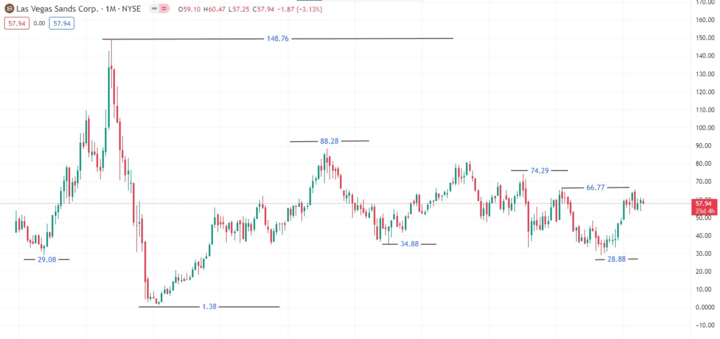Over the past few years, Las Vegas Sands Corp. has demonstrated a commitment to improving the work-life balance of its employees, and this has only improved with the introduction of the 360-degree approach to team member advancement. This novel approach focuses on fostering healthy work-life balance and engaging families in fun and meaningful activities. Thus, in turn, optimizing employee devotion and customer satisfaction.
Also, on April 4, 2023, Las Vegas Sands Corp. released its ESG (environmental, social, and governance) report. The report showed that, thus far, the company has successfully met and even exceeded its targets in several respects. One particular one is achieving a 50% greenhouse gas emission cut in 2022, already surpassing its 2025 target of 17.5%. This highlights the fact that Las Vegas Sands Corp. is a company with a devotion to eco-friendly practices.
Based on the above, it's pretty easy to see why LVS stock is an excellent investment option for you, irrespective of whether you're a trader or an investor. However, before we go into an in-depth examination of LVS stock's performance and forecasts, let's take a brief overview of Las Vegas Sands Corp.
Las Vegas Sands Corp's Overview

Credit: Company Website
Las Vegas Sands Corp. was founded on November 17, 1988, by Sheldon Adelson. Currently, the company has its headquarters in Las Vegas, Nevada. Las Vegas Sands Corp. operates integrated resorts with offerings such as gaming, entertainment, convention, and exhibition facilities, restaurants, and shopping. Its primary segments are located in Las Vegas, Macau, and Singapore.
The current CEO of Las Vegas Sands Corp. is Robert Goldstein. Goldstein has been with the company since its early days, and before this, he held numerous executive roles with Las Vegas Sands Corp. since becoming a part of the team in 1995. Currently, Las Vegas Sands Corp. is backed by top institutional shareholders like T. Rowe Price Associates, Inc. (4.31% ownership of the company), The Vanguard Group, Inc. (4.05% ownership of the company), and Capital Research & Management Co. (3.25% ownership of the company).
Key Milestones
Since its founding, Las Vegas Sands Corp. has achieved several remarkable milestones. Some of these include the following:
- In 1990, the Sands Expo and Convention Center debuted, boasting over 2 million square feet, making it one of the world's grandest privately-owned convention hubs.
- In 2004, Las Vegas Sands Corp. went public and acquired its first Asian property in Macau, China.
- In 2007, The Venetian Macao was launched, holding the title of the world's most vast inhabited structure.
- In 2009, The Sands Casino Resort Bethlehem was unveiled, moving the gaming epicenter of the eastern United States from New Jersey to eastern Pennsylvania.
- In 2010, Las Vegas Sands Corp. introduced the iconic Singapore Marina Bay Sands, now a national landmark.
Las Vegas Sands Corp's Business Model and Products/Services

Credit: Company Instagram
Las Vegas Sands Corp. generates revenue through its integrated resort model, which encompasses various streams. These include casino gaming, hotels, entertainment venues, shopping, and dining. The business model is designed to cater to a broad audience, from tourists and convention attendees to high-rolling gamblers. By offering a multifaceted entertainment experience, the corporation capitalizes on several profitable sectors, leveraging the interconnectedness of these segments to boost overall revenues.
Main Products and Services
The main products and services of Las Vegas Sands Corp. are centered around the gaming and hospitality industries. These include:
- Gaming: Casino operations with a wide array of games.
- Hospitality: Luxury hotels and resorts.
- Entertainment and Retail: Convention centers, entertainment venues, shopping centers, and fine dining restaurants.
Together, these offerings make Las Vegas Sands Corp. a significant player in the entertainment and leisure industry, driving its revenues and maintaining its position as a leader in the market. In the next section, we'll closely examine LVS stock's financials and valuation.
Las Vegas Sands Corp's Financials, Growth, and Valuation Metrics

Credit: iStock
Las Vegas Sands Corp. currently has a market capitalization of $44.29 billion. For the quarter ending on June 30, 2023, Las Vegas Sands Corp. reported a net income of $0.312 billion, marking a significant 207.59% decrease compared to the previous year. The company's net earnings for the year culminating on June 30, 2023, stood at $51 million, reflecting a sharp drop of 97.08% year-over-year.
On a brighter note, their revenue for the same quarter surged to $2.542 billion, witnessing a robust 143.25% growth year-over-year. Tracking the trajectory of LVS stock over the past five years, revenue has declined from $13,729 in 2018 to $4,110 in 2022. As of June 30, 2023, Las Vegas Sands Corp's net profit margin rests at 0.75%, with the gross margin for LVS stock price at 46.51%.
Further financial metrics indicate that, as of June 30, 2023, the company has a return on equity of 1.32%. Las Vegas Sands Corp.'s long-term debt is $14.849 billion as of June 30, 2023. In terms of cash flows, 2022 ended with a negative free cash flow of $-1.586 billion for Las Vegas Sands, although this was a 49.06% improvement from 2021. Also, for the recent quarter ending on June 23, 2023, Las Vegas Sands Corp.'s free cash flow is $1,020.00.
Key financial ratios and metrics

Credit: iStock
Currently, the P/E ratio for LVS stock stands at 206.93. In comparison, its industry rivals, MGM Resorts (MGM) and Red Rock Resorts (RRR), report P/E ratios of 136.33 and 13.94, respectively. This suggests that the market expects higher future growth from LVS stock. For the initial quarter of 2023, the P/S ratio for Las Vegas Sands stock is 6.54. In contrast, MGM Resorts (MGM) and Red Rock Resorts (RRR) have P/S ratios of 1.26 and 2.33, respectively, for the same period. Similarly, this indicates that the market sees LVS stock as having better profit margins and more significant growth potential than its competitors.
The LVS stock price at present is $57.94, while its estimated fair value is $63.09, suggesting that the LVS stock might be slightly undervalued at the moment. This potentially offers an attractive entry point for investors.
LVS Stock Performance Analysis

Credit: Company Instagram
Las Vegas Sands Corp. had its IPO in December 2004. LVS stock is traded on the New York Stock Exchange (NYSE) under the ticker "LVS". Since it is listed on the NYSE, LVS stock is traded in the United States, and transactions are conducted in U.S. dollars (USD).
Standard NYSE trading hours are from 9:30 AM to 4:00 PM Eastern Time (ET) on regular business days (Monday to Friday, excluding certain holidays). Pre-market trading for LVS stock, like other NYSE-listed securities, typically starts at 4:00 AM and ends at 9:30 AM ET. After-hours trading begins right after the standard trading hours at 4:00 PM and usually ends at 8:00 PM ET.
LVS Stock Split: Currently, Las Vegas Sands stock has no stock split history.
LVS Stock Dividends: Las Vegas Sands stock pays a quarterly dividend of $0.20 and has an annual dividend yield of 1.38%.
LVS Stock Price Performance Since its IPO

Credit: TradingView
After its IPO, LVS stock price briefly dipped to the 29.08 level before going on a massive bullish run to reach the 148.76 price level, LVS stock's all-time high. After this, however, LVS stock price significantly dipped to 1.38.
Las Vegas Sands stock price then gradually rose again till it reached the 88.28 price level before falling back to 34.88. LVS stock price then rose briefly to the 74.29 price level before falling to 28.88.
Recently, LVS stock has been going on a bullish movement, with the price targeting the old high of 66.77. If LVS stock can gather enough momentum to break this high, the next target will be the 74.29 price level.
Key Drivers of LVS Stock Price
- Gaming Revenues: This is one of the most influential factors for the LVS stock price. As one of the primary sources of income, consistent growth or decline in these revenues can directly impact the LVS stock price.
- Global Tourism Trends: LVS stock price is heavily influenced by global tourism patterns. A rise in international travelers, especially in regions where Las Vegas Sands Corp. has significant operations like Macau and Singapore, can boost their revenues. Conversely, any factor reducing tourism, like geopolitical tensions or health crises, can negatively affect the Las Vegas Sands stock price.
- Regulatory Changes: The gaming and hospitality industry faces strict regulations, so any significant regulatory changes in the jurisdictions where LVS operates can affect the LVS stock price. For instance, changes in gambling laws or licensing can either create opportunities or pose challenges for the company.
LVS Stock Forecast

Credit: iStock
The current general analyst consensus regarding Las Vegas Sands stock is a buy. According to a 16-analyst price prediction for Las Vegas Sands Corp, the consensus median target is $70.00, while the high and low LVS stock price projections are $80.50 and $64.00, respectively. Of the 16 analysts, 13 believe LVS stock is a buy.
Challenges and Opportunities
Two prominent competitors of Las Vegas Sands Corp in the gaming and hospitality industry are MGM Resorts (MGM) and Red Rock Resorts (RRR). Both of these companies have offerings that could potentially impact or determine Las Vegas Sands' stock price performance.
For example, MGM Resorts has a broad global footprint with diversified revenue sources. So their aggressive expansion strategies and significant presence in both Las Vegas and Asia could eat into LVS's market share. Also, Red Rock Resorts has deep-rooted connections in the Las Vegas local market that can challenge LVS's dominance in the region.
That said, you should know that overall, LVS does retain the competitive advantage. Las Vegas Sands Corp. boasts a range of integrated resorts across multiple countries, giving it a diversified revenue stream and lessening its reliance on a single market. Also, LVS's properties, like The Venetian and Marina Bay Sands, are globally recognized, ensuring a steady flow of tourists and guests.

Credit: Company Instagram
Other Risks
Some other risks potentially affecting LVS stock include the following:
- Health Crises: Events like pandemics can drastically reduce travel and tourism, leading to decreased revenues for Las Vegas Sands Corp.'s properties.
- Technological Disruption: The rise of online gambling platforms could divert some of the traditional casino-going audiences.
- Cultural Shifts: Changes in the public's perception of gambling, driven by cultural or generational shifts, could impact the industry's broader appeal.
Growth Opportunities
- Digital Transformation: With the rise of online gambling and digital entertainment, Las Vegas Sands Corp. could tap into the digital casino space, building platforms or partnering with existing online gambling entities. For example, they could focus on developing a Las Vegas Sands-branded online casino or mobile betting app.
- Emerging Markets: LVS can also expand into countries or regions that are easing their gambling restrictions or are witnessing a surge in tourism. For example, they could explore opportunities in countries like Japan, which has been gradually opening up to the idea of integrated resorts.
Future Outlook and Expansion

Credit: iStock
- New Properties: There's always the potential for Las Vegas Sands Corp. to open new integrated resorts in high tourism flow regions or emerging markets. For example, they could consider acquiring new properties in Southeast Asian countries with high tourist traffic.
- Renovate and upgrade: Also, LVS can reinvent and upgrade its existing properties to align with modern trends, ensuring they remain top attractions. A tech-driven renovation of The Venetian to include smart rooms or augmented reality experiences would greatly increase customer satisfaction and thus positively impact LVS stock price.
Why Traders Should Consider LVS Stock
Not sure if LVS stock is the right investment opportunity for you? Here are some reasons why you should definitely consider trading Las Vegas Sands stock:
- Diverse Portfolio: LVS's global presence across multiple countries offers a diversified revenue stream, insulating it from economic downturns in any one region.
- Strategic Growth Opportunities: LVS's potential for digital transformation and expansion into emerging markets presents significant growth potential.
- Competitive Edge: Despite stiff competition from brands like MGM and RRR, LVS's strategic locations and top-tier entertainment offerings give it a distinct advantage.
- Analysts' Consensus: Expert opinion concerning LVS stock is that it's currently a very strong buy. As such, it presents a prime profit-making opportunity for traders and investors.
Trading Strategies for LVS Stock

Credit: iStock
There are several strategies you can employ when trading LVS stock to ensure you remain consistently profitable. Some of these include the following:
- CFD Trading: Contract for Difference (CFD) trading will allow you to speculate on the price movement of LVS stock without owning the underlying stock itself. This means you can potentially profit from both rising and falling markets.
- Dividend Capture Strategy: This strategy involves purchasing LVS stock just before the dividend ex-date and selling it right after the dividend is paid. The aim is to capture the dividend payout while limiting exposure to the stock's price fluctuations.
- Momentum Trading: The momentum trading strategy involves buying LVS stock when it shows upward price momentum and selling it when the momentum starts to weaken.
While all of the above strategies are pretty good for trading LVS stock, it has to be said that the CFD option remains the best option. Some advantages of the CFD trading strategy for Las Vegas Sands stock include the following:
- Leverage: You will be able to control a large position with a small amount of capital when trading LVS stock, thus amplifying potential profits. However, you should know that this also increases your risk.
- No Stamp Duty: Unlike traditional stock trading, CFDs usually don't incur stamp duty (varies by jurisdiction).
- Hedging: CFDs can be used to hedge against potential losses in other investments or stock holdings.
Trade LVS Stock CFD with VSTAR
To trade LVS stock CFDs, you'll need to have an account with a CFD provider. This is where VSTAR comes in. VSTAR is an institutional-level trading platform that offers several amazing benefits for both beginners and pro traders. Some advantages of trading LVS stock CFD with VSTAR include:
- Ultra-low Trading Cost: VSTAR offers the benefit of trading LVS stock CFDs without incurring hefty fees. Their tight spreads ensure that the difference between the buying and selling price is minimal, and with no commission charges, traders retain a larger portion of their profits.
- Top-tier Deep Liquidity: VSTAR boasts top-tier deep liquidity, ensuring that large orders can be filled without substantial price slippages. This ensures that you will be able to execute sizeable trades without worrying about adversely impacting LVS stock's price.
- Lightning-fast Order Execution: VSTAR offers a trading platform where orders on LVS stock CFDs are processed within milliseconds. This rapid execution ensures that you'll get in or out of positions at your desired price levels.
Conclusion
Las Vegas Sands Corp. has a history of exceptional service and strong financial performance. In addition, an overview of LVS stock's performance also shows lots of promise in terms of growth and the future forecast. As such, LVS stock currently presents an excellent investment opportunity for traders and investors. So download VSTAR today to get started with trading LVS stock CFD.




